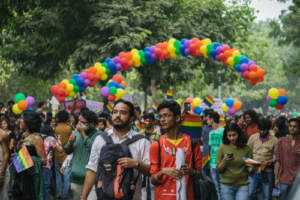LGBTQ Indians Score a Major Supreme Court Victory
 In early September 2018, multiple news outlets all over the world reported a landmark decision by India’s Supreme Court to decriminalize same-sex love. LGBTQ Indians celebrated the ruling, which overturned a criminal law that threatened their safety, dignity, and civil rights for more than 150 years. To understand the context of this development, it’s important to learn the backstory behind the original law as well as how colonization played a part in this aspect of India’s history.
In early September 2018, multiple news outlets all over the world reported a landmark decision by India’s Supreme Court to decriminalize same-sex love. LGBTQ Indians celebrated the ruling, which overturned a criminal law that threatened their safety, dignity, and civil rights for more than 150 years. To understand the context of this development, it’s important to learn the backstory behind the original law as well as how colonization played a part in this aspect of India’s history.
The Indian Supreme Court Decision
The Times of India revealed that the country’s Supreme Court struck down Section 377 of the Indian Penal Code on September 6, with all six of its justices signing the verdict. The original text of the provision called same-sex activity “against the order of nature,” punishable by fines and incarceration for up to 10 years. The New York Times quoted Chief Justice Dipak Misra’s statement that the law was “irrational, indefensible and manifestly arbitrary,” then added that the court’s ruling extended all the protections of the country’s Constitution to LGBTQ Indians.
The Independent clarified that the fight for Section 377’s decriminalization has lasted for nearly two decades. The Naz Foundation was one core advocacy group that remained at the forefront of Indian activism against Section 377. A 2009 ruling that would have rendered the statute null and void was defeated when a small panel of the Supreme Court insisted that Parliament would have to rule on the matter. Another 2013 ruling upheld Section 377, and multiple attempts to introduce bills overturning it in India’s legislature failed. The September 6 ruling was hailed as a victory, coming after several months of the court’s deliberations.
Pre-Colonial Culture and LGBTQ People
Prior to British colonial rule, queerness and transgender individuals were part of cultures throughout the Indian subcontinent. Even when Mughal-era laws technically criminalized same-sex affection between men, homoerotic themes and desires were common among upper-class men. Before Muslim rule, multiple characters throughout Hindu and Vedic texts bent gender norms and loved others of the same sex. Pre-colonial literature speaks of the “tritiya prakriti,” a third gender group that encompassed people we’d recognize today as transgender, nonbinary, genderqueer, gender nonconforming, and intersex.
How Did Section 377 Become Law?
The Indian Penal Code was created in 1861 during Britain’s occupation of India, but the Times of India explained that Section 377 was specifically modeled after an anti-sodomy statute passed by England’s Parliament in 1533. These laws resulted in the criminal convictions of men such as Irish poet and playwright Oscar Wilde and computer scientist Alan Turing.
CNN reporter Ben Wescott disclosed that Section 377 was just one example of anti-queer and anti-transgender laws that were commonplace in lands colonized by the British. Unfortunately, many of these statutes are still enforced in many parts of the world. According to Wescott, the legal codes of 31 countries contain the original anti-LGBTQ colonial legislation. A May 2018 piece in The Conversation discussed Trinidad and Tobago’s recent decriminalization of same-sex love but added that leftover British anti-LGBTQ statutes are still present in the legal codes of several African nations:
- Uganda
- Ghana
- Gambia
- Kenya
- Nigeria
- Zambia
Enze Han and Joseph O’Mahoney further explicated that British colonial governments devised such laws as part of their goal to impose their versions of “Christian morals” upon the native peoples they ruled. Many of these codes explicitly outlawed same-gender activity between men but were curiously silent about same-sex affection between women.
A Significant Development for Indian LGBTQ Rights
Much remains to be done for improving LGBTQ civil rights in India. Nevertheless, the ruling against Section 377 is a step in the right direction. Meanwhile, queer and transgender Indians of all ages continue to challenge their society, calling for it to revert from colonialist norms and embrace them as equals.














